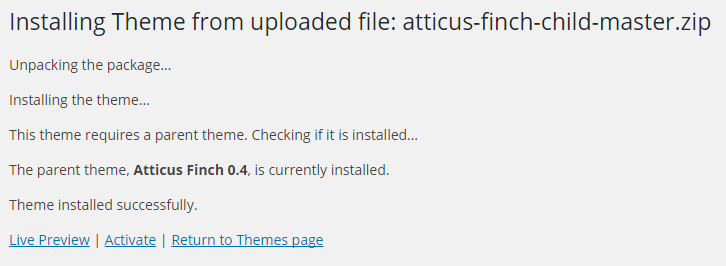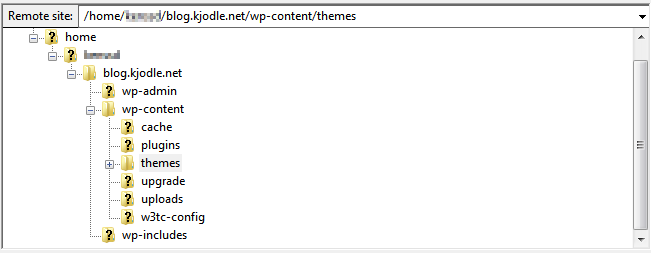Difference between revisions of "Atticus Finch Child Theme"
m (→Examples: Added note about downloading snapshots.) |
|||
| Line 103: | Line 103: | ||
== Examples == | == Examples == | ||
| − | If you would like to see examples of the child theme files in action (including added and modified theme files), I have added examples you can view and download on my public Git server at http://git.kjodle.net/public | + | If you would like to see examples of the child theme files in action (including added and modified theme files), I have added examples you can view and download on my public Git server at http://git.kjodle.net/public. |
| + | |||
| + | To download a complete version, click on a commit and then click on the snapshot link. | ||
Latest revision as of 00:26, 5 June 2017
Installing the Child Theme
Atticus Finch has a child theme available which allows you to easily add or change functions and styles. (You should never edit a theme's files directly. Always use a child theme.) Here's how to install it.
Upload the Child Theme to Your WordPress Install
First, get the child theme:
- Download the child theme from this link: https://github.com/kjodle/atticus-finch-child/archive/master.zip
- Save the file (atticus-finch-master.zip) to whichever location on your computer you prefer.
Uploading the Child Theme via the WordPress Backend
- On your website, navigate to Appearance => Themes.
- Click the "Add New" button at the top
.
- Click the "Upload Theme" button at the top
.
- Click "Choose File" and select the child theme .zip file.
- Click "Install Now".
- After a moment, you should see a message similar to this one:

- Click "Activate". You can now edit the child theme's style.css and functions.php from the theme editor (Appearance => Editor).
Uploading the Child Theme via FTP
- Save the file (atticus-finch-master.zip) to whichever location on your computer you prefer.
- Rename the folder "atticus-finch-child-master" to "atticus-finch-child". (This step is optional.)
- Unpack the .zip archive. Delete the .gitignore and <tt.gitattribute files.
- Login to your site via FTP. (If you do not know your FTP login credentials, you will need to contact your web host.)
- Navigate to "/wp-content/themes/" directory:

- Upload the "atticus-finch-child" folder to your "/wp-content/themes/" directory.
- On your website, navigate to Appearance => Themes.
- Activate the "Atticus Finch Child" theme. You can now edit the child theme's style.css and functions.php from the theme editor (Appearance => Editor), or you can edit them locally and upload them via FTP.
Customization via a Child Theme
Changing Styles via the Child Theme
The child theme will automatically load its own style sheet in /atticus-finch-child/style.css. You can add your own styles or override any theme styles there.
If you need to change mobile styles, go to the child theme's /atticus-finch-child/functions.php and uncomment the mobile line. In other words, change this:
<code> /* If you need to make changes to the child theme's mobile styles, uncomment the following line and edit the child theme's '/styles/mobile.css' file. */ // wp_enqueue_style( 'atticus-finch-child-mobile-style', get_stylesheet_directory_uri() . '/styles/mobile.css', 'atticus-finch-mobile', wp_get_theme() -> get( 'Version' ), 'screen and (max-width: '. get_theme_mod( 'atticus_finch_mobile_breakpoint' ) . 'px)' ); </code>
to this:
<code> /* If you need to make changes to the child theme's mobile styles, uncomment the following line and edit the child theme's '/styles/mobile.css' file. */ wp_enqueue_style( 'atticus-finch-child-mobile-style', get_stylesheet_directory_uri() . '/styles/mobile.css', 'atticus-finch-mobile', wp_get_theme() -> get( 'Version' ), 'screen and (max-width: '. get_theme_mod( 'atticus_finch_mobile_breakpoint' ) . 'px)' ); </code>
The child theme will now load /atticus-finch-child/styles/mobile.css. Make your mobile changes there. (Note: These changes will only apply when the mobile version of the theme is loaded, as set in the | mobile theme options.
You can also edit menu styles and print styles by making similar changes.
Note: Any time that you change the child theme, you should update the Version: number in style.css. By doing so, you ensure that the latest version of your child theme style sheets will load, rather than pulling the old versions out of either a server or browser cache.
Adding HTML or Scripts to WordPress
Atticus Finch supports both the wp_head() and wp_footer() functions. To use either function, simply uncomment out the appropriate function in functions.php and add your code between the closing and opening PHP tags.
For example, to add a simple "Hello, World" message to the <head> element:
Uncomment out the relevant function and add your HTML by changing this:
<code>
/* Add HTML or scripts to the <head> element by uncommenting the function below */
/*
function atticus_finch_header() { ?>
Add your code here.
<?php }
add_action ('wp_head','atticus_finch_header');
*/
</code>
to this:
<code>
/* Add HTML or scripts to the <head> element by uncommenting the function below */
function atticus_finch_header() { ?>
Hello, World.
<?php }
add_action ('wp_head','atticus_finch_header');
</code>
You can also use PHP by elminating the closing and opening PHP tags:
<code>
/* Add HTML or scripts to the <head> element by uncommenting the function below */
function atticus_finch_header() {
echo 'Hello, World.';
}
add_action ('wp_head','atticus_finch_header');
</code>
Achieving More Granular Placement of Code
Keep in mind that WordPress does not always place your code exactly where you want it, especially if you are loading a lot of other scripts. To more precisely place your code, copy the theme's header.php or footer.php files to the child theme folder and make your changes there.
Examples
If you would like to see examples of the child theme files in action (including added and modified theme files), I have added examples you can view and download on my public Git server at http://git.kjodle.net/public.
To download a complete version, click on a commit and then click on the snapshot link.
